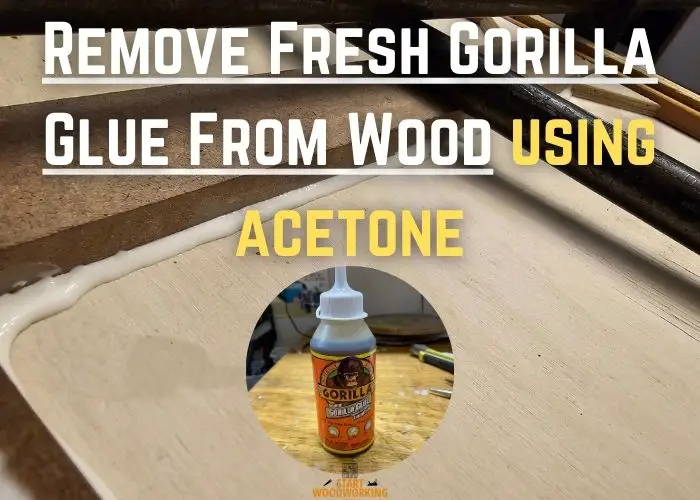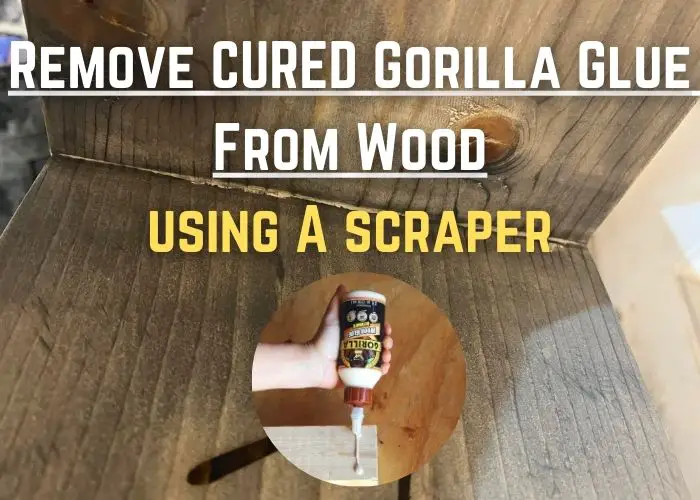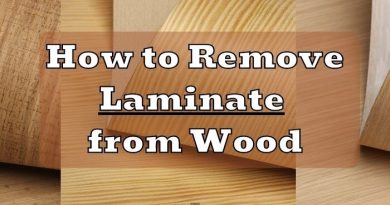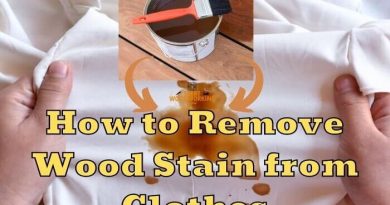Remove Gorilla Glue from Wood: 3 Quick and Effective Ways!
Gorilla glue is a very strong glue and can become a headache if you don’t know how to properly remove it from wood without damaging it and without leaving traces.
To remove Gorilla Glue from wood, gently scrape off any excess dried glue with a blunt tool or knife. If the glue is still wet, use paper towels and acetone to wipe it up immediately for the best results. For tougher spots, a chisel can help lift the glue, especially if there’s dust or wax beneath it.
Remove Fresh Gorilla Glue From the Wood Surface

Be careful not to gouge the wood with the spatula.
Always wear protective clothing and gloves with glues to avoid skin exposure.
Use safety glasses or eye protection if there is a risk of eye exposure.
Things you need:
- Paper napkins
- Acetone (nail polish removal)
- Scrape spatula
Step 1: Wipe Away Excess Glue
Before the Gorilla Glue sets, I use paper napkins to clean off as much excess glue as possible. It’s important to act quickly and remove the glue gently with the napkin to avoid spreading it further on the wood surface. I always use disposable towels to avoid transferring the adhesive to another surface.
Step 2: Apply Acetone with a Napkin
I then moisten a fresh paper napkin with acetone, which is a common component in nail polish remover. When purchasing nail polish remover for this purpose, I make sure it contains acetone by checking the label.
I pour a small amount onto the napkin, enough to dampen it without soaking it through. Paint thinner or hardware store acetone can also be used, but I’m cautious with these as they’re stronger and could damage the wood’s finish.
Step 3: Scrub the Gorilla Glue with Acetone
Using the moistened napkin, I quickly scrub over the Gorilla Glue stain on the wood. I apply firm pressure to help break down the adhesive without allowing the glue to set further.
If the napkin starts to dry out, I apply more acetone and continue scrubbing until no more glue lifts off.
Step 4: Scrape Off Remaining Glue
After the acetone has softened the Gorilla Glue, I use a scrape spatula to gently remove any remaining adhesive. I hold the spatula flat against the wood and carefully edge it under the glue, scraping it away. I work slowly and meticulously to avoid gouging the wood.
Step 5: Final Cleaning and Wood Restoration
If any residue persists, I might apply additional acetone with a napkin to soften it again. If the wood’s finish has been affected, I may lightly sand the area with 80-grit sandpaper, taking care to only remove the glue and not damage the wood.
Once the glue is fully removed, I clean the area with a dry cloth and, if necessary, touch up the finish to restore the wood to its original condition.
You can apply more acetone with a napkin to re-expose the glue. In the end, the wood will go back to normal. 80-grit sandpaper is another option. This can damage the wood if you are not careful. Scrub the glue and stop when you reach the wood.
Pros:
- Effective Solvent: Acetone is a powerful solvent that can break down the adhesive properties of Gorilla Glue, making it easier to remove from the wood surface.
- Quick Action: Acetone works quickly to soften the glue, which is especially useful when dealing with fresh spills before they harden.
- Accessibility: Acetone is readily available as it’s a common ingredient in nail polish remover, making it a convenient option for many users.
Cons:
- Potential Damage to Finish: Acetone can strip away or damage the finish of the wood if not used carefully, necessitating additional refinishing work.
- Harmful Fumes: Acetone emits strong fumes that can be harmful if inhaled, requiring good ventilation and possibly protective gear during use.
Remove Cured Gorilla Glue from Wood
1. Scraping using a Spatula

Things you need:
- Paint scraper or Plastic Putty Knife
- Chisel
- Polishing block
Step 1: Scrape Off the Bulk of the Glue
Begin with a paint scraper or plastic putty knife, which is an ideal tool for lifting large chunks of dried gorilla glue from the wood surface. Hold the paint scraper with the flat edge against the wood and apply downward pressure to wedge the edge beneath the glue.
Push the scraper forward to peel away the gorilla glue in strips. Repeat this process where you see more substantial amounts of glue.
Step 2: Use a Chisel for Smaller Areas
Switch to a chisel for smaller, hard-to-reach areas where the paint scraper isn’t effective. The chisel’s smaller head allows for more precise control. Use the same scraping motion as with the paint scraper to chip away at the remaining glue.
Step 3: Sand the Gorilla Residue
After removing the majority of the glue, use a polishing block or a 150-180 grit sanding pad to sand away any residual adhesive. Apply light pressure and focus on the glue to avoid damaging the wood. If you’re experienced with power tools, an electric sander can expedite this process, but use it with caution to prevent over-sanding.
Step 5: Address Stubborn Residue
If there’s stubborn adhesive film remaining, or if there are delicate areas that might be damaged by scraping and sanding, carefully use a dental pick and magnifying glass to meticulously remove the glue. This method requires patience and a gentle touch to avoid harming the wood surface.
Pros:
- No Chemicals Required: This method avoids the use of harsh solvents or chemicals, which is better for your health and the environment.
- Control and Precision: Using a spatula or chisel provides more control over the removal process, allowing for precise scraping in targeted areas without affecting undamaged wood.
- Cost-Effective: Scraping requires basic tools that most woodworkers already possess, eliminating the need for additional purchases.
Cons:
- Potential for Damage: If not done carefully, scraping can gouge or scratch the wood surface, especially if the tools used are not adequately sharp or are applied with too much force.
- Time-Consuming: Scraping off cured glue is labor-intensive and can be very time-consuming, especially for larger areas or intricate woodwork.
2. Using Heat
Step 1: Heat the Glue
I start by setting up my heat gun or hair dryer to a moderate heat setting. Holding it about 6 inches away from the cured gorilla glue, I apply heat evenly across the wood area.
I keep the heat source moving in a constant back-and-forth motion to avoid scorching the wood. The goal is to soften the gorilla glue without damaging the wood’s finish.
Step 2: Scrape the Softened Glue
Once the glue is soft and pliable, I take a plastic scraper or a putty knife with a dull edge and gently slide it underneath the edge of the glue.
I maintain a low angle to reduce the risk of gouging the wood and use steady, even pressure to peel the glue away. If the glue cools and hardens, I reapply heat as needed to keep it soft.
Step 3: Remove Residue and Refinish
After the bulk of the glue is removed, there might still be some residue. I lightly sand the area with fine-grit sandpaper, following the grain of the wood to blend the sanded spot with the surrounding area.
Then, I clean the surface with a dry cloth to remove any dust. If necessary, I touch up the spot with a matching wood finish or stain, allowing it to dry according to the product’s instructions.
Finally, I apply a wood polish or wax to enhance the wood’s natural beauty and provide a protective layer.
Pros:
- Non-Invasive: Heat application is a non-invasive method that doesn’t involve harsh chemicals or solvents, making it safer for both the person doing it and the environment.
- Effective Softening: Heat can effectively soften the cured glue, which makes the scraping process easier and less likely to damage the wood.
- Controlled Application: Using a heat gun or hair dryer allows for controlled application of heat, enabling the user to target specific areas without affecting the surrounding wood.
Cons:
- Risk of Scorching: If not careful, the high temperature can scorch or burn the wood, especially if the heat is applied for too long in one spot.
- Potential to Affect Finish: Heat can potentially damage or discolor the wood finish, requiring additional refinishing work after the glue is removed.
- Requires Caution: This method requires careful handling of the heat source and scrapers to avoid personal injury and damage to the wood.
3. Using a Baking Soda & Vinegar Mix
Step 1: Create the Mixture
First, I would mix equal parts of baking soda and white vinegar to create a paste. The vinegar acts as a mild solvent, which helps to dissolve the glue, and the baking soda serves as a gentle abrasive to help lift the glue from the wood surface.
Step 2: Apply the Paste
Next, I would apply the paste directly onto the cured Gorilla Glue. I would use a spatula or an old toothbrush to spread the mixture, ensuring it fully covers the glue. It’s important to apply a thick layer to allow the mixture to work effectively.
After applying the paste, I would let it sit on the glue for about 15 minutes to an hour. This allows the vinegar time to penetrate and soften the glue, and the baking soda to start breaking down the adhesive properties of the glue.
Step 3: Scrub the Area
Once the time has elapsed, I would use a scrub brush or an old toothbrush to gently scrub the area in a circular motion. The abrasive nature of the baking soda combined with the scrubbing action helps to lift the glue from the wood.
After scrubbing, I would use a damp cloth to wipe away the paste and loosened glue. I might need to rinse the cloth several times to ensure all the residue is removed from the wood surface.
Step 4: Repeat if Necessary
If any glue remains, I would repeat the process, applying a new batch of the vinegar and baking soda mixture, letting it sit, and then scrubbing until the glue is completely removed.
Step 5: Neutralize and Condition the Wood
Once the glue is gone, I would rinse the area with water to neutralize the acidity of the vinegar and prevent any potential damage to the wood. Then, I would dry the area thoroughly with a clean cloth.
If the wood’s finish has been affected, I would touch it up with a wood stain or sealant that matches the original finish and let it dry according to the manufacturer’s instructions.
Finally, I would apply a wood conditioner or polish to restore the wood’s natural luster and provide a protective coating.
Pros:
- Eco-Friendly: This method uses non-toxic, household ingredients, making it an environmentally friendly option for glue removal.
- Safe for Wood: The mild nature of the solution is less likely to damage the wood compared to harsher chemical removers.
- Cost-Effective: Baking soda and vinegar are inexpensive and commonly available, making this an economical choice for adhesive removal.
Cons:
- May Require Multiple Applications: Tougher glue spots may need several treatments, which can be time-consuming.
- Potential for Incomplete Removal: This method may not be as effective on fully cured or thicker applications of Gorilla Glue, leaving behind some residue.
| Removal Method | Finished Wood | Unfinished Wood | Painted Wood |
|---|---|---|---|
| Scraping with a Spatula or Chisel | Use with caution to avoid damaging the finish. A plastic scraper is preferred. | Ideal for this surface as it can handle more aggressive techniques. | Use with caution to avoid removing paint. A plastic scraper is preferred. |
| Using Heat (e.g., Heat Gun or Hair Dryer) | Effective, but high risk of damaging the finish. Keep the heat moving and use a low setting. | Effective, especially if followed by sanding to smooth the surface. | Risky as heat can bubble or peel the paint. Use with extreme caution. |
| Baking Soda & Vinegar Mix | May affect the finish, so test in an inconspicuous area first. | Suitable as the wood can be sanded and refinished if necessary. | Not recommended as the vinegar can strip or damage the paint. |
| Acetone or Solvent-Based Remover | Can remove or damage the finish, so it should be used sparingly and with caution. | Effective, as the wood can be sanded and refinished if necessary. | Likely to damage the paint, so it should be avoided unless planning to repaint. |
| Commercial Adhesive Remover | Choose a product designed for finished surfaces and test first. | Generally suitable, but follow manufacturer’s instructions. | Not recommended unless you plan to strip and repaint the wood. |
The safest method involves using a combination of heat and a putty knife. Gently apply heat with a hairdryer set to medium heat to soften the glue, being careful not to overheat and damage the wood finish. Once softened, use the putty knife to carefully scrape off the glue. If any residue remains, apply a little olive oil or mineral oil, let it sit for a few minutes, then wipe clean.
For a more natural approach, you can try using vinegar, which can soften Gorilla Glue. Soak a cloth in white vinegar and place it over the glue spot for several minutes. Once the glue softens, gently scrape it off with a plastic scraper or putty knife. Repeat as necessary, and then wipe the area clean with a damp cloth.
If a residue remains after the initial removal, you can use a cloth dampened with rubbing alcohol or a mixture of baking soda and coconut oil to break down the remaining adhesive. Gently rub the mixture onto the residue, let it sit for a few minutes, then wipe away with a clean cloth. Repeat if needed until the wood is clean.




